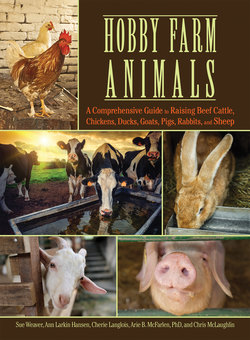Читать книгу Hobby Farm Animals - Chris McLaughlin - Страница 15
На сайте Литреса книга снята с продажи.
Handling Facilities
ОглавлениеCows are bigger, stronger, and faster than we are, so when it’s time for vaccinations or shipping, we need a way to make them hold still (other than trying to rope them or grab a tail). You can’t hold a half-ton cow if it doesn’t want to be held, and generally it doesn’t. That’s why cattle owners should—for their own safety, if nothing else—have a cattle-handling facility.
Cattle facilities have four parts: a corral or holding pen, a crowding tub, an alley, and a chute with a headgate. The small operator really needs only these four basic components. Even if you have just a couple of steers for the summer, you’ll still need some sort of pen and a chute to load them onto the truck at the end of the year. Make sure to locate your facilities where they will allow easy access for a truck and trailer.
The pen or corral holds the cattle until you’re ready to work them. A few at a time are herded into the crowding tub, which is a small, circular pen with a swing gate that pushes them into the alley. The alley is narrow, so cattle don’t have room to turn and must go single file. At the end of the alley, a grate is raised to let a single animal at a time into the chute, where the cow or steer’s neck is caught in the headgate. This holds the cattle in one place so you can safely administer shots, put on ear tags, or do whatever else may need to be done. Once the vaccinating, breeding, or castrating is done, the headgate is released, and the animal moves back out to pasture. The headgate is then reset for the next patient.
When planning your handling facilities, follow these few basic principles. First, unless it never rains in your area, put your facility inside a building or on cement, or both. It’s no fun working in the mud. Old dairy barns can be easily converted for working beef cattle, as can nearly any sort of shed. Our facility is on a cement pad outside the old barn.
Second, plan for curves, good footing, and good lighting. A slippery surface will make cattle nervous, and they will balk if they see a barrier ahead. They will, however, follow a curve around to its end. They also will move more readily toward a well-lit area than a dark one.
Finally, if you’re building with raw materials rather than buying manufactured components, follow the recommended dimensions exactly. The recommended alley width for your breed of cattle may seem incredibly narrow, but anything wider and you’ll have cattle trying to turn around, which can result in injuries. Never force a heavily pregnant cow into the alley or chute—it might get stuck.
With a little creativity, it’s possible to build a fine facility at a reasonable cost in a fairly small area. Ours is built on a 75 × 50-foot concrete pad next to the old dairy barn. We also use the area for moving tractors and equipment in and out of a shed. We hung a lot of gates that we usually leave open for mechanical traffic but close when handling cattle in order to subdivide the area into three separate pens that wrap around to feed into each other and then into the crowding tub. I bought a manufactured tub, alleyway, and headgate, all of which we bolted to heavy-duty wooden posts that we cemented in so the cows couldn’t push things out of alignment. The result may not be aesthetically beautiful, but for working cattle, it functions wonderfully. The water tank and grain feeders are also situated on the concrete inside the holding pens so the cattle go in there to eat and drink and are very familiar with the setup, which makes for calm and easy handling.
